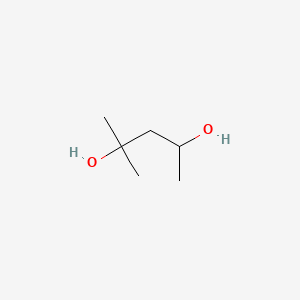m6A-centered Drug Response Information
General Information of the Drug (ID: M6APDG02999)
| Name |
2-Methyl-2,4-Pentanediol
|
||||
|---|---|---|---|---|---|
| Synonyms |
2-METHYL-2,4-PENTANEDIOL; 107-41-5; 2-Methylpentane-2,4-diol; Pinakon; 2,4-Dihydroxy-2-methylpentane; 2,4-Pentanediol, 2-methyl-; Diolane; Isol; 4-Methyl-2,4-pentanediol; 1,1,3-Trimethyltrimethylenediol; 2-Methyl pentane-2,4-diol; 2-Methyl-2,4-pentandiol; Caswell No. 574; alpha,alpha,alpha'-Trimethyltrimethylene glycol; 1,3-dimethyl-3-hydroxybutanol; Hexylene glycol [NF]; HSDB 1126; 1,3,3-trimethyl-1,3-propanediol; (+-)-2-Methyl-2,4-pentanediol; NSC 8098; EINECS 203-489-0; EPA Pesticide Chemical Code 068601; BRN
Click to Show/Hide
|
||||
| Status |
Investigative
|
||||
| Structure |
 |
||||
| Formula |
C6H14O2
|
||||
| InChI |
1S/C6H14O2/c1-5(7)4-6(2,3)8/h5,7-8H,4H2,1-3H3
|
||||
| InChIKey |
SVTBMSDMJJWYQN-UHFFFAOYSA-N
|
||||
| PubChem CID | |||||
| TTD Drug ID | |||||
Target Gene(s) and Their Upstream m6A Regulator, Together with the Effect of Target Gene(s) in Drug Response
The target genes involved in drug-target interaction (such as drug-metabolizing enzymes, drug transporters and therapeutic targets) and drug-mediated cell death signaling (including modulating DNA damage and repair capacity, escaping from drug-induced apoptosis, autophagy, cellular metabolic reprogramming, oncogenic bypass signaling, cell microenvironment, cell stemness, etc.) could be regulated by m6A regulator(s) and affected their corresponding drug response. You can browse detailed information on drug-related target gene(s) mediated by m6A regulators.
Heat shock protein 90 alpha (HSP90A)
Fat mass and obesity-associated protein (FTO)
| In total 1 mechanisms lead to this potential drug response | ||||
| Response Summary | Heat shock protein 90 alpha (HSP90A) is a therapeutic target for 2-Methyl-2,4-Pentanediol. The Fat mass and obesity-associated protein (FTO) has potential in affecting the response of 2-Methyl-2,4-Pentanediol through regulating the expression of Heat shock protein 90 alpha (HSP90A). | [1], [2] | ||
Methyltransferase-like 3 (METTL3)
| In total 1 mechanisms lead to this potential drug response | ||||
| Response Summary | Heat shock protein 90 alpha (HSP90A) is a therapeutic target for 2-Methyl-2,4-Pentanediol. The Methyltransferase-like 3 (METTL3) has potential in affecting the response of 2-Methyl-2,4-Pentanediol through regulating the expression of Heat shock protein 90 alpha (HSP90A). | [1], [2] | ||
YTH domain-containing family protein 2 (YTHDF2)
| In total 1 mechanisms lead to this potential drug response | ||||
| Response Summary | Heat shock protein 90 alpha (HSP90A) is a therapeutic target for 2-Methyl-2,4-Pentanediol. The YTH domain-containing family protein 2 (YTHDF2) has potential in affecting the response of 2-Methyl-2,4-Pentanediol through regulating the expression of Heat shock protein 90 alpha (HSP90A). | [2], [3] | ||
Nitric oxide synthase endothelial (NOS3)
Fat mass and obesity-associated protein (FTO)
| In total 1 mechanisms lead to this potential drug response | ||||
| Response Summary | Nitric oxide synthase endothelial (NOS3) is a therapeutic target for 2-Methyl-2,4-Pentanediol. The Fat mass and obesity-associated protein (FTO) has potential in affecting the response of 2-Methyl-2,4-Pentanediol through regulating the expression of Nitric oxide synthase endothelial (NOS3). | [4], [5] | ||
References